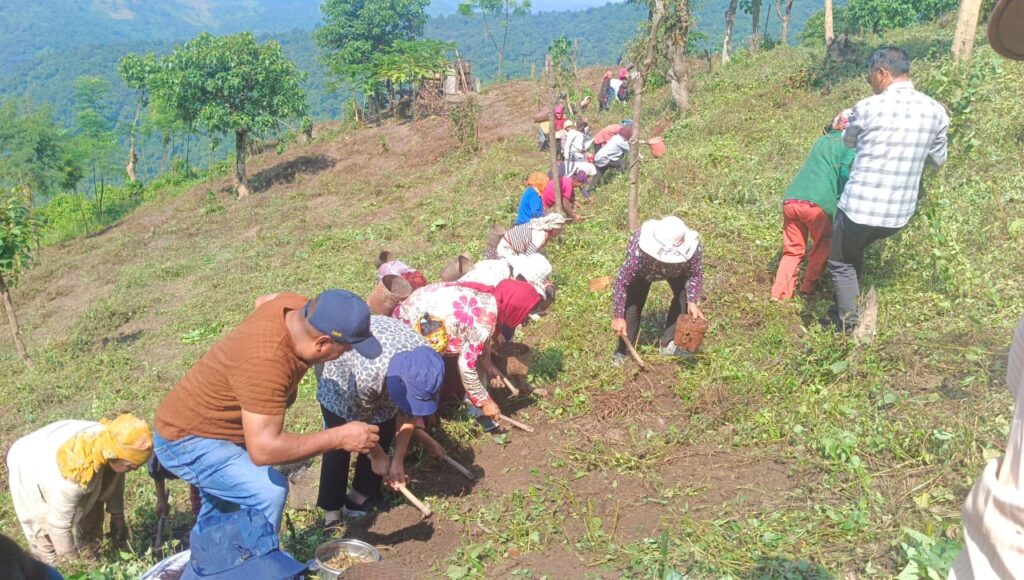The term ‘Khodam’ has its origins in the traditions of Ghokimi’s ancestors. In Ghokimi style, ‘Khodam’ is defined as a combination of ‘kho’ (in Sumi dialect) meaning ‘to crack open’ and ‘dam,’ derived from the Hindi word ‘badam,’ which means ‘to crack open the peanut shell.’ This term might be surprising, as most people are accustomed to the word ‘badam’ referring to almonds, but in Ghokimi, ‘Khodam’ actually means peanuts (mungfali). Opening a peanut shell requires a specific method, as the top edge of the peanut shell resembles the short, curved, downward-facing beak of an owl bird, which is used to crack it open with fingers and thumb.
It is believed that Khodam was first obtained from the Lothas. In Ghokimi village, Lt. Ashu Qhieshe Swu and his wife Lt. Shovili were the first to use Khodam (peanut seeds) between 1958-1959. Since then, Ghokimi villagers have diligently sown and harvested Khodam. It’s not only their best crop but also a prized possession.
Ghokimi, located in Nagaland, is a fertile land with abundant green vegetation, nestled among lush landscapes and hills. The village falls under the Pughoboto sub-division in Zunheboto district and is 65.9 km from the state capital, Kohima. The villages of Asukiqa, Ghokimi, Tsaphimi, Kitami, and Puneboqa belong to the Asukiqa area.
Ghokimi’s history is linked to Ashu Ghoki, who brought 80 warriors (Aghutomi) from the land of Awohumi to settle in this area. He named the village ‘Ghokimi’ and established a colony called ‘Phuyekito.’ One of the four colonies in Ghokimi is named Phuyekito, marking its significance. The village has five Goan Buras and approximately 140 households.
Peanuts, known by various names such as groundnuts, earthnuts, goobers (in the U.S.), or monkey nuts (in the U.K.), belong to the legume crop Arachis hypogaea, mainly grown for their edible seeds. Peanuts are known for their unique taste and texture, and they offer health benefits, including being a good source of healthful fats, protein, fiber, potassium, phosphorus, magnesium, B vitamins, and other nutrients.
The land in Ghokimi is fertile, and despite relying on natural rainfall for cultivation, it yields a variety of fruits and vegetables, all grown organically without pesticides or chemicals. In addition to peanuts, the villagers cultivate yams, pumpkins, bottle gourds, squash, corn, ginger, chili, beans, soybeans, and more. The cultivation pattern involves growing vegetables in the first year, followed by peanuts in the second year, with the fields lying fallow for eight to nine years afterward.
Peanuts are unique because they flower above the ground, but the peanuts themselves grow underground, making sandy loamy soil ideal for their growth. The peanut plant has a growing cycle of 4-5 months.
In Ghokimi, Khodam is sown from late April to May, with the ideal sowing period considered to be between May 10 and 20. Farmers keep a close watch on the fields from germination to harvest, requiring monthly weeding and mulching. Khodam seeds are sown about one and a half inches deep and 12-14 inches apart. The germination of peanut seeds depends on rainfall and can take up to a month. After sowing, the plant develops yellow flowers, and once pollinated, it sends pegs into the soil, and the peanuts grow underground. A single plant can produce between 20-50 peanuts.
Harvesting typically takes place in October when the peanut leaves turn dark, and the pods are collected from the plants. After loosening the soil, the matured peanuts are collected, and the plants are pulled up, leaving the pods attached. Weather conditions and wildlife, like wild boars, can affect the peanut harvest.
The presence of wild boars in the area poses a significant challenge to the Khodam fields. While harvesting, farmers need to contend with flies, bees, ants, insects, termites, and caterpillars, in addition to allergies, heat, and potential rainfall. Despite these challenges, the farmers continue their work with dedication.
The Khodam also has economic importance, supporting households and enabling the payment of school fees for children. Ghokimi villagers typically sell Khodam in 15-liter tins for Rs. 500 each. While purchasing Khodam is straightforward, harvesting it is a challenging task, and the presence of wild boars can lead to financial losses. Despite the setbacks, the generous nature of the villagers means they often gift Khodam to loved ones and friends.
The taste of freshly harvested Khodam, toasted over an open fire, is noted for its natural and aromatic flavor, far superior to store-bought peanuts. It is enjoyed with a cup of sweet black tea and is said to set one’s taste buds on fire. The shared experience of toasting Khodam encourages social bonding, with families sitting around the fireplace, toasting peanuts and making tea together.
Wild boars pose a significant threat to Khodam fields, and efforts to deter them are challenging. The male and female wild boars attack the fields at different times, causing emotional and financial distress to the villagers.
Khodam is popular not only in Ghokimi but also in surrounding towns and areas, with consistent orders coming from Dimapur, Kohima, Zunheboto, and Pughoboto. The villagers sell Khodam at festivals and even export it, with foreign tourists, especially Americans, showing enthusiasm for the product.
In summary, Khodam is not just a crop but a way of life for the people of Ghokimi, who cultivate it with dedication and care, and celebrate its unique flavor and cultural significance.
Regenerated from Article published in 2019 by Aboli T Wotsa

